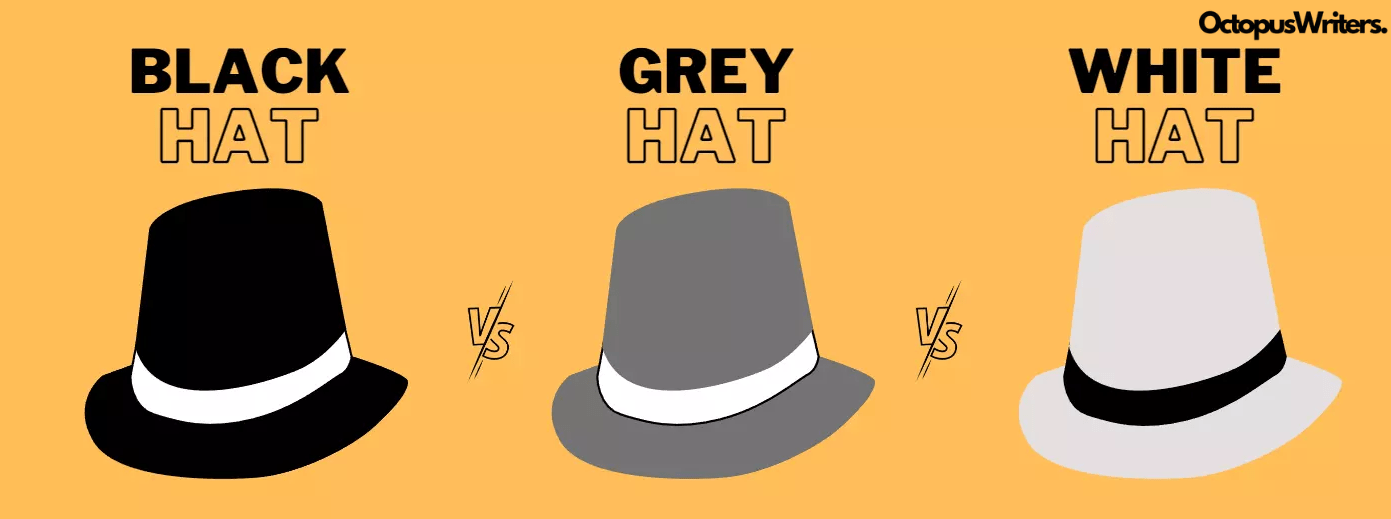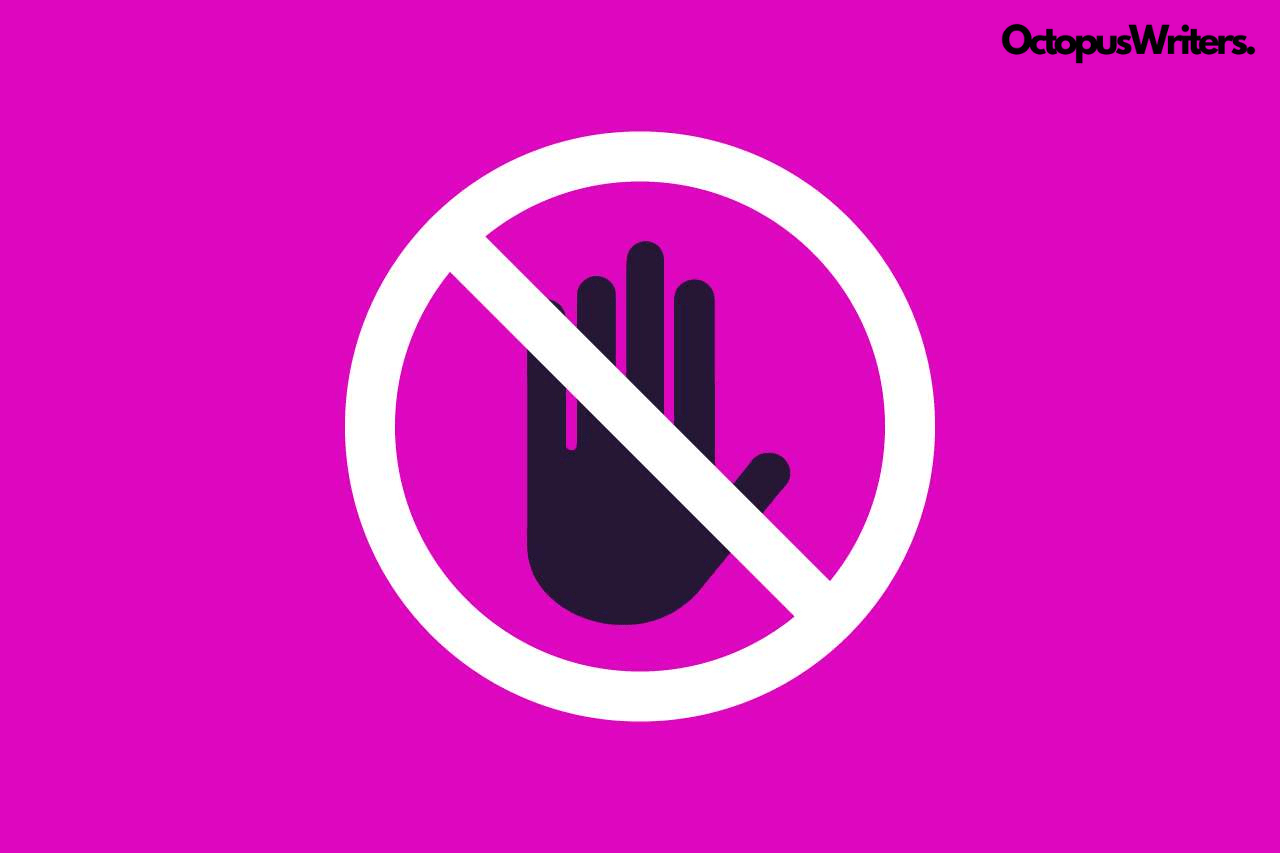Gray Hat SEO in 2024 blends elements of both white and black hat tactics, offering potential gains while pushing the boundaries of search engine guidelines. As algorithms evolve, understanding these strategies can give businesses an edge, but they come with risks.
In this article, we’ll explore the key aspects of Gray Hat SEO and why it remains a debated topic in digital marketing. OctopusWrites shares insights on how to leverage these tactics responsibly for better search rankings.
What is Gray Hat SEO?
Gray hat SEO combines both white hat and black hat tactics. For example, creating high-quality content is a white-hat method, while buying backlinks for that content is a black-hat tactic. Using both strategies together, like producing great content and purchasing backlinks, forms a gray hat approach that skirts search engine guidelines.

A typical gray hat technique is acquiring backlinks to boost domain authority. Many sites request backlinks via contact forms, though Google advises using its Search Console for link submissions. While not penalized, this practice isn’t encouraged, placing it in a gray area.
Understanding gray hat SEO requires recognizing the difference between white hat and black hat techniques. White hat SEO follows guidelines and emphasizes ethical strategies, while black hat uses manipulative methods. Gray hat SEO lies between these two, using tactics that aren’t outright banned but may carry risks.
Why is Gray Hat SEO important?
Gray hat SEO is increasingly common across various niches, but it comes with significant risks. Google may penalize your site for using these tactics, leading to long-term repercussions. While gray hat techniques can offer quick wins, they are not advisable for businesses focused on sustainable growth, as they can undermine your site’s credibility.
Understanding gray hat SEO is crucial for several reasons. It helps you avoid questionable practices, ensuring your strategy adheres to ethical guidelines. This knowledge also allows you to evaluate your SEO contractors and protect your site’s reputation from risky tactics.
Additionally, being aware of gray hat techniques helps you monitor competitors effectively. By identifying any gray hat strategies they may use, you can adapt your approach and refine your SEO efforts for long-term success without compromising your site’s integrity.
Is Gray Hat SEO illegal?
No, gray hat SEO is not illegal, but it operates in a precarious area of search engine optimization. While it can involve practices that aren’t explicitly prohibited, these tactics can still lead to penalties if not handled carefully. Since gray hat SEO sits between white hat and black hat strategies, it is considered partially safe but riskier than white hat approaches.

For businesses, understanding gray hat SEO is essential to optimize online presence effectively. Although it may offer quick visibility and higher rankings, prioritizing ethical practices and long-term sustainability is crucial for maintaining credibility with both search engines and users. Striking a balance between effective optimization strategies and adherence to best practices will help ensure your SEO efforts align with your long-term goals.
Gray Hat SEO vs White Hat SEO vs Black Hat SEO
When examining the spectrum of SEO practices, we find white hat SEO at one end and black hat SEO at the other. Gray hat SEO falls in between; it involves strategies that are “tweaked” to boost rankings in search engines without completely violating guidelines. In contrast, black hat SEO employs tactics that are clearly against search engine recommendations and best practices.

White hat SEO techniques are the ideal target for any website owner. They focus on creating original, high-quality content, engaging in legitimate link building through relationships, link exchanges, or guest blogging, and providing a valuable user experience on your site.
Conversely, black hat SEO techniques directly violate Google’s guidelines, aiming for quick results in SERPs. These tactics can include using software to build links, creating duplicate content, employing doorway pages, or redirecting through expired domains. Such practices can lead to severe penalties, causing your site to be de-indexed from search engines like Google and Bing, resulting in a significant loss of organic traffic and potentially destroying your website.
Gray hat techniques occupy a middle ground, primarily involving link-building strategies and methods for attracting traffic that aren’t explicitly against Google’s guidelines. However, they still operate on a tightrope, requiring careful consideration to avoid crossing over into black hat territory.
Gray Hat SEO examples
Here are a few examples of gray hat SEO tactics:
Using Cold Emails for Outreach
Cold emailing is a common gray hat tactic where outreach teams pitch products or services to potential clients with no prior contact. It’s considered safer than buying links since it doesn’t involve payment. While some emails may end up in spam, effective email marketing tools can generate valuable leads when personalized and targeted correctly.
Leveraging Low-Quality Websites for Backlinks
Using low-quality websites to build backlinks can improve your site’s domain authority and boost PageRank. However, if these sites are deemed too spammy, it could trigger penalties from search engines. Instead, focus on creating high-quality content that attracts backlinks from reputable sources.
Content Scraping and Automated Tools
Content scraping involves repurposing information from other sites, but excessive copying can lead to copyright issues. Similarly, automated tools can help identify backlink sources quickly, but over-reliance on automation may result in generic pitches that harm your reputation. Balancing automation with personalized outreach is crucial for effective link-building strategies.
By understanding these gray hat techniques, businesses can leverage them strategically while being aware of the associated risks, maintaining a strong SEO presence without compromising integrity.
Should you use Gray Hat SEO techniques?
Gray hat SEO techniques continue to gain popularity, but it’s important to recognize that the risks often outweigh the rewards. For personal blogs, experimenting with low-risk strategies might be feasible. However, for businesses aiming for long-term success, it’s advisable to stick to white hat SEO methods, which prioritize ethical practices and compliance with search engine guidelines.

Engaging in gray hat tactics can put your website at risk of penalties from Google. If you’re uncertain whether a particular strategy may violate guidelines, it’s typically safer to avoid it altogether. Maintaining a solid reputation with search engines is crucial for sustaining organic traffic and visibility.
Marketers need to evaluate the balance of risk versus reward based on their specific circumstances. With Google’s algorithms becoming increasingly stringent, businesses are better off committing to strictly white hat SEO practices. This approach not only minimizes the chance of penalties but also builds trust with both search engines and users over time.
Some Gray Hat SEO techniques

Keep in mind that it’s not the technique itself that defines gray hat SEO, but rather how a tactic is executed that categorizes it as such.
Here are some common SEO techniques that can easily cross into gray hat territory.
Creating content that doesn’t offer value
Every page and blog post should provide genuine value to visitors by answering questions, directing them to relevant resources, and highlighting great deals. In contrast, the gray hat approach often focuses on keyword optimization at the expense of real substance. While keyword research can identify promising topics, it often leads to content that drives traffic without meaningful engagement.
This strategy may initially attract visitors, but it fails to retain them as users quickly recognize the lack of valuable information. When visitors realize your website offers little merit, they are unlikely to return, and Google will take note of your high bounce rate. When crafting blog posts, focus on delivering comprehensive, engaging, and easily digestible content that directly addresses users’ search intent, ensuring a valuable experience that encourages repeat visits.
Using expired domains
You may come across ownerless domains with rich histories and hundreds of backlinks for sale. Purchasing these expired domains can boost your new website’s authority and is often a better option than starting from scratch, making this practice a gray hat SEO tactic.
By redirecting traffic from these domains, you can pass along valuable “link juice” from reputable sites. If you’re willing to put in extra effort, you can even revive the entire website by accessing cached content, potentially helping your new site rank quickly. However, redirecting to unrelated websites or reviving a site in an unfamiliar niche can be risky.
While building backlinks and creating content from scratch can be tedious, it’s the best way to establish a trustworthy site. By prioritizing quality and relevance, you’ll attract visitors and encourage long-term growth.
Using hosted blogging platforms to build backlinks
Blogging platforms like Medium and Tumblr have built-in audiences, allowing you to publish content that includes valuable backlinks. This practice is often viewed as a gray hat SEO technique, leaning more toward white hat. If you create engaging content linking to relevant resources, you’re following best practices. However, gaining significant attention on these platforms can be challenging, as most clicks go to viral posts or popular authors.
Some users create multiple accounts on platforms like Medium or Substack to interlink their content, which violates Google’s black hat guidelines and can result in penalties. While adding backlinks on these platforms may seem beneficial, it’s unlikely to help your original website unless you have an established audience or create viral content.
For better results, consider publishing new content directly on your target site or seeking guest blogging opportunities from established authors. This strategy can yield more meaningful backlinks and enhance your overall SEO efforts.
Paying for reviews
Google prioritizes search results with positive reviews, as users are more likely to trust these recommendations. If your business features strong testimonials and effective local SEO, you can rank among the top results in your area. However, accumulating numerous good reviews can take time. Some business owners attempt to speed up this process by paying for positive reviews, which many consider a black hat SEO tactic. Although it can be hard to detect, this approach falls into gray hat territory.
Buying Google reviews is similar to purchasing social media followers; these testimonials are often fake and offer little genuine value. Moreover, Google can remove fraudulent reviews at any time, leaving you without recourse for your investment. While this tactic might provide a short-term boost in local SEO rankings, it poses significant risks. If Google penalizes your business, it could lead to lasting damage to your listing and reputation.
Native advertising and partnerships
Native advertising has become a widely recognized term in recent years. This type of advertising seamlessly integrates into the content of a website, making it appear more like a part of the editorial experience rather than a traditional ad.
When links are acquired through native advertising, with clear intent disclosed and the content genuinely enriching for readers, it can be categorized as a gray hat practice.
Here are some examples of native advertising in action:
- A sponsored article featuring “The Benefits of Mindfulness” on the Huffington Post, promoting a wellness app.
- A video ad by Coca-Cola that blends storytelling and product placement within a popular YouTube series.
- An infographic shared by a tech company on BuzzFeed that highlights industry trends while subtly promoting their products.
To maintain transparency and uphold ethical standards in native advertising, it’s essential to include clear disclosures about sponsorships and the intent behind the content.
Paying for citations and listings
Many companies invest in premium business listings and citations to enhance their visibility.
For instance, insurance companies often pay substantial fees to be listed on aggregator cost comparison sites. This exposure is crucial for them, as lacking visibility can lead to lost business opportunities to competitors.
Google supports listings on reputable, official directories. However, when businesses prioritize quantity over quality in their online listings, this practice can easily slip into gray hat territory.
Affiliate marketing
Affiliate marketing is a legitimate strategy where marketers promote products through unique links and earn commissions for sales or leads. When done ethically, it fosters genuine relationships between consumers and brands, benefiting both parties.
However, it can quickly turn gray hat when deceptive tactics, such as misleading claims or fake reviews, are used. These practices can damage trust and harm the reputations of both marketers and brands, leading consumers to avoid them.
To stay on the right side of ethics, affiliate marketers should be transparent about their relationships and provide honest reviews. By focusing on real value, they can build trust and maintain the integrity of the affiliate marketing model.
Many social media accounts
It’s widely recognized that your customers are active on social media. A white hat SEO approach involves maintaining a single business account on each platform to share links and enhance exposure and visibility. Conversely, creating multiple accounts to artificially inflate your sharing rate and link to your site falls into gray hat SEO territory.
While great content is essential for improving rankings, search engines also weigh social signals significantly. Establishing multiple social media accounts can help boost your online and social presence, but creating numerous fake accounts is not advisable. To establish yourself as a credible professional in your niche, it’s better to focus on genuine engagement rather than relying on dubious tactics.
Submit site to web directories
Web directory submission is a commonly employed gray hat SEO strategy. By submitting your site to various directories, you can obtain free backlinks simultaneously. However, if you limit the submissions to a few high-quality directories, this approach aligns with white hat SEO practices.
On the other hand, when you excessively submit your website to numerous directories to accumulate a large number of links, it transitions into gray hat territory. This overuse can lead to penalties from search engines, as it may be perceived as an attempt to manipulate rankings. To maintain ethical SEO practices, it’s essential to strike a balance by focusing on quality over quantity in your directory submissions.
Duplicate content
Duplicate content occurs when the same text is reused across a website or on different sites and is commonly seen in gray hat SEO through:
- Targeting Similar Queries: Businesses may create multiple pages with identical content for various city locations, changing only the city name to attract similar searches without new content.
- Copying from Other Websites: Replicating content from a lesser-known site onto a more authoritative domain can sometimes lead to outranking the original source and redirecting traffic.
- Flooding Search Engines: Submitting multiple copies of the same content to search engines aims to manipulate rankings and visibility.
These tactics might provide temporary advantages but risk long-term credibility and SEO effectiveness if detected by search engines.
Cloaking
Cloaking is a significant gray hat SEO tactic that involves showing different content to search engines than what is presented to human users. This strategy aims to manipulate search engine rankings by displaying a keyword-rich version of a webpage to search engines while users see an unrelated or less informative page.
For instance, a website may optimize a page for search engines to boost visibility but direct users to content that doesn’t meet their expectations. While cloaking can result in short-term traffic gains, it poses substantial risks, as search engines like Google are increasingly adept at detecting such deceptive practices. If caught, websites can face severe penalties, including drops in rankings or removal from search engine results altogether. Thus, while cloaking may seem appealing for quick visibility, it ultimately jeopardizes a site’s credibility and reputation.
Gray Hat SEO tactics you must avoid

Gray-hat SEO tactics remain prevalent, it’s best to steer clear of them. Here are some practices you should avoid:
Buying Links
Building links requires time and resources, but the rewards are substantial. However, the temptation to take shortcuts can be strong. For instance, purchasing links violates Google’s webmaster guidelines and can harm your search rankings.
Here’s why buying backlinks is not advisable:
- It contradicts Google’s guidelines.
- It can lead to penalties from Google.
- The average cost is around $360 per link, making it an expensive option.
Instead of buying backlinks, consider guest blogging. This approach allows you to showcase your writing skills and expertise while earning high-quality links at the same time.
Keyword stuffing
A few years ago, simply stuffing keywords into your webpage could boost your search rankings. However, it’s no longer that straightforward. Google’s algorithm has evolved significantly, making it essential to use the right amount of keywords for better rankings. Overloading your content with keywords not only undermines the algorithm but also negatively impacts user experience, leading to lower rankings.
Instead, focus on the following strategies:
- Create in-depth, well-researched content that provides real value.
- Explore a variety of topics to engage a broader audience.
- Develop pillar and cluster topics to enhance content organization.
- Incorporate long-tail keywords within your detailed articles to attract targeted traffic.
Negative SEO
This tactic involves creating multiple spammy links to a competitor’s website in an attempt to sabotage their rankings. Such black hat SEO practices are no longer effective, as Google can identify and eliminate these spammy links.
Not only is this method unethical, but it also carries severe penalties for those caught engaging in it. Instead of trying to undermine competitors, consider these strategies:
- Outperform your competition with high-quality content. Focus on identifying target keywords that resonate with your audience and create content aligned with their search intent. You can use the same keyword in different articles as long as each addresses distinct user needs.
- Build backlinks ethically. Reach out to high-authority sites to request backlinks. While this falls under gray hat SEO, it is generally safe and won’t result in penalties if done correctly.
By securing high-quality backlinks, you can enhance your page’s authority and improve your search engine rankings without resorting to unethical tactics.
PBN (private blog network)
A Private Blog Network (PBN) consists of a collection of websites designed solely to generate backlinks for a primary site. By embedding links within this network, users aim to manipulate search algorithms to boost their main site’s rankings.
Instead of resorting to manipulative tactics, consider the following strategies:
- Guest Posting: Write articles for reputable sites in your niche to gain valuable backlinks.
- Social Media Backlinks: Share your content on social media platforms to attract natural backlinks.
- Ethical Link-Building Methods: Focus on creating high-quality, relevant content that naturally earns links.
By prioritizing quality over quantity, you can improve your search engine rankings sustainably and responsibly.
Gray Hat SEO- Frequently Asked Questions
What is an example of a gray hat hacker?
Example of Real-World Gray Hat Hacking: In 2013, computer security researcher Khalil Shreateh discovered a vulnerability that enabled him to post on Mark Zuckerberg’s Facebook wall. After reporting the glitch to Facebook, he ultimately exploited it to demonstrate the security flaw.
What is the difference between black hat SEO and gray hat SEO?
Unlike black hat SEO, gray hat SEO employs techniques that don’t necessarily breach search engine guidelines. While these methods may not lead to direct penalties for your website, they remain risky as they manipulate search engine rules to enhance a page’s rankings in search engine results pages (SERPs).
What is gray hat SEO strategy?
Gray hat SEO refers to techniques that fall between approved search engine practices and unethical methods. This includes strategies like using expired domains, creating private blog networks, and spinning content. While these tactics aren’t outright black hat, they still carry a degree of risk and ethical ambiguity.
How many hats are there in SEO?
There are various approaches to optimizing content effectively, but it’s essential to adhere to the correct guidelines. SEO strategies can be divided into three distinct categories: Black Hat, White Hat, and Gray Hat SEO.
Is it grey or gray hat?
A gray hat (or grey hat) refers to a computer hacker or security expert who occasionally violates laws or ethical standards but typically lacks the malicious intent associated with black hat hackers.
Conclusion
In summary, effectively navigating the realm of Gray Hat SEO in 2024 necessitates a thoughtful balance between utilizing techniques to boost visibility and upholding ethical standards. Although gray hat tactics may provide quick wins, the associated risks—like search engine penalties—can threaten your website’s long-term success. Emphasizing strategies that prioritize quality content, authentic engagement, and sustainable growth is crucial for establishing a strong online presence.
For more insights on effectively managing your SEO strategy while minimizing risks, visit OctopusWrites. We provide valuable resources to help you make informed decisions in the ever-evolving world of digital marketing.

